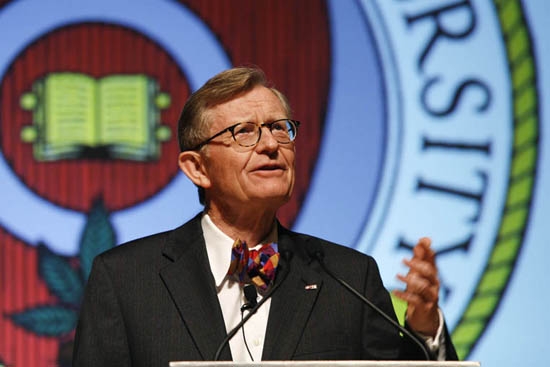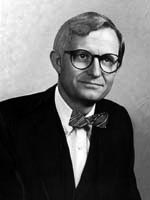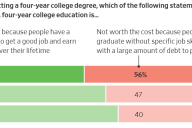You have /5 articles left.
Sign up for a free account or log in.

E. Gordon Gee
E. Gordon Gee, whose retirement as president of Ohio State University was thought to end his career as a highly paid and seasoned college executive, is not going away after all. Instead, Gee, who turns 70 in February, is suddenly preparing for his seventh presidency.
Next month, he’ll become interim president of West Virginia University, the state flagship where Gee began his presidential career in 1981 at age 36. Since then, Gee has led the University of Colorado, Ohio State, Brown University, Vanderbilt University, and then Ohio State again.
His second Ohio State stint ended this summer shortly after disparaging remarks he made about the University of Notre Dame and Roman Catholics became public. It appeared that Gee would finish out his career teaching, although he remained a visible higher ed sage for Ohio Governor John Kasich.
But then WVU was left scrambling to find a president when its current leader abruptly announced his departure last month to take the top job at Clemson University.
Gee was wooed privately and by phone. He made no visit to the university’s campus in Morgantown as part of the search, which was conducted in closed-door “emergency” and “special” sessions by the university’s 17-member Board of Governors.
James Dailey, the chairman of WVU’s board, called Gee and asked him if he was interested. By both men’s account, Gee called back not long afterward and said he was. “I thought about it and then decided it would just be a wonderful thing to do, given that I know the institution and have such a wonderful respect for it and for the state,” Gee said.
About a quarter of the candidates were people who submitted their own names, but other candidates might not have even known they were considered. Gee was one of four finalists, Dailey said. All finalist interviews were conducted by phone, Dailey said, and none of the finalists had face-to-face interviews.
Dailey said the board looked at Gee’s “credentials and pedigree -- that is certainly stellar -- and we knew how much he loved West Virginia and how much he cared about us and what he accomplished when he was here.”
Dailey said the board discussed Gee’s Catholic comments, but only briefly. One board member, whom Dailey said was Catholic, brought up the remarks and said they were taken out of context. Two other Catholic board members -- the vice chairman and board secretary -- chimed in to agree the comments were not an obstacle.
Dailey called Gee and offered him the job. Gee said it was an “easy decision.” Gee, who once made well over $1 million a year at Ohio State, can earn just $450,000 a year at WVU, according to the university -- though he is unlikely to stay long enough to earn a year's pay. As part of the deal, he will be able to keep working on projects to improve the higher ed system in Ohio. He is forbidden from seeking the permanent presidency of WVU.
Gee said he took the job after talking to C. Peter Magrath, the veteran higher ed administrator to whom WVU turned as interim president following the departure of a short-lived, scandal-besmirched president who was forced out in 2008. Gee, who knows Magrath, said Magrath “encouraged me greatly to do it.”
Gee will serve through the spring until WVU can find a permanent leader. That new permanent president will be WVU’s sixth president in seven years, including the two interims, Gee and Magrath.
Gee’s foreseeable tasks will be to help the university get through an upcoming visit by its accreditors and deal with another round of budget reductions by the state.
Gee, who said he has raised billions in his career, is credited with helping to reshape West Virginia’s fund-raising arm during his first stint as president from 1981-1985. The university is in the midst of a $750 million capital campaign and has been aiming to attract more research funding.
“We think he can help us with our research dollars, we think he can help us with our donor dollars,” Dailey said.
Gee’s first time at WVU is also notable because he helped figure out how to pay for a new university hospital, which is now one of the state’s largest.
But, Gee said, he’s not going to be able to pick up just where he left off.
“One of the mistakes on my part would be to come back and think of West Virginia as the institution I knew,” Gee said.
In the past, he has joked his second stint at Ohio State was a chance for him to clean up the mess he left in his first.
Gee left WVU for the University of Colorado. He now says he wanted to be closer to home, his native Utah. All his subsequent presidencies have been east of the Mississippi.
West Virginia Governor Earl Ray Tomblin is planning a round of budget cuts next year that will fall hard on higher ed, which makes up about a tenth of the state’s general revenue budget.
The state already cut higher ed this year, by 7.5 percent. Similar cuts to higher ed are expected this year. If they go through as planned, the state will be funding higher ed in 2015 with the same amount of money it did in 2000, according to the state’s Higher Education Policy Commission. As a result, WVU will end up with about $22 million less in annual state appropriations in the next budget versus two budget cycles ago. The total operating budget at WVU from all sources is about $950 million.
Dailey and Gee both said they want Gee to maintain the course set by outgoing President Jim Clements, who is leaving for Clemson. Neither Gee or Dailey suggested Gee had any mission other than to keep an even keel.
Asked if he had any major plans, Gee said Sunday, “This just happened less than a week ago. The No. 1 goal is to maintain the momentum of the institution and, No. 2., to make sure I’m of some help.”








